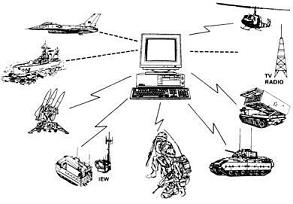At the recent Ground Robotics Capability Conference (GRCC), I surveyed a number of vendors about what was on their mind. I read them a list of topics that are frequently covered in OCU Pro newsletters as well as AMREL’s corporate blog.
By far, one topic elicited more interest than any other: interoperability. On one hand, I was pleased. AMREL has been a leader for developing solutions that have the ability to “… to work with or use the parts or equipment of another system” (Merriam-Webster definition). For example, our Flexpedient® Solutions enable kit building of Operator Control Units with common control capabilities.
On the other hand, I was surprised. I have been under the impression that many people in the industry were ignoring interoperability. The Department of Defense has been pushing interoperability for years, but developers have stubbornly built proprietary systems that don’t work and play well with others.
However, the participants at the GRCC weren’t talking about this kind of “interoperability.” They were concerned about the ability for multiple robots to operate in the same environment without interference from one another. This might be more properly termed RF deconfliction (or spectrum management), which is “avoiding radio interference between neighboring frequencies.”
One application developer described how he couldn’t operate a medium-sized Unmanned Ground Vehicle (UGV) near an overseas airport, because it interfered with the manned aircraft landing. He also referred to an unmanned system demonstration in which the video signal “jumped”; the UGV picked up another system’s video data stream. In fact, while he told me this story at the GRCC, we heard announcements asking vendors to turn off their robots, because they were interfering with the unmanned systems that were being demonstrated. As the application developer said, “Bandwidth is more precious than gold and platinum.”
Unmanned systems are especially sensitive to interference. Unlike vehicles that carry the operator, unmanned systems must rely on radio contact for purposes of command and control.
Another reason unmanned systems are vulnerable to radio interference is their frequent use on missions for Intelligence, Surveillance and Reconnaissance (ISR). Sensors collect electronic signals, optical images, radar data, and infrared images on sea, ground, and in the air. To illustrate the growing demands on bandwidth, look at the visual images collected by Unmanned Aerial Vehicles (UAV). Originally, they focused on one target at a time, Defense Advanced Research Projects Agency (DARPA) developed Autonomous Real-time
Ground Ubiquitous Surveillance-Imaging System (ARGUS–IS) with the goal that a single UAV can have 65 independent video feeds. Add in 3D imaging, and it’s easy to understand Lt. Gen. David A. Deptula, Air Force deputy chief of staff for ISR’s famous statement, “We’re going to find ourselves in the not too distant future swimming in sensors and drowning in data.”
In addition to ISR and command & control, bandwidth is needed for radar, geolocation, navigation, and standard communications. Add in the estimated 10, 000 IED jammers used in Iraq, and the spectrum begins to look a mite crowded.
Interoperability (in the more conventional meaning of the term) plays a role in this as well. As mentioned above, the DoD has been mandating interoperability for years, but there has been little success in developing enforceable standards for the military as a whole. Unmanned systems are developed for a specific service, with little or no thought for interoperability. In the words of Army Electromagnetic Spectrum Management Operations (2006) “Spectrum management is often addressed as an afterthought in both the acquisition and operational processes.”
In joint operations, technical patches may be used to allow communications between two normally incompatible systems. This slows down data flow, which increases the demand on the already overburdened spectrum. For planning of joint operations, especially those involving coalition forces, spectrum management is essential to prevent “frequency fratricide.”
Even without this electromagnetic traffic jam, radio control of unmanned systems is not exactly robust. Hills, walls, buildings, and other obstacles impede radio control. Even in test conditions, the Department of Homeland Security found that radio interference seriously compromised the effectiveness on 70% of the robots.
Bandwidth is a unique asset. It is comparable to bullets or oil in that it is a limited resource. Unlike most limited resources it is reusable. You burn oil once, but the same frequency can be use over and over again by different applications.
Despite the inherent flexibility of the spectrum, sections of the usable radio spectrum are dedicated to specific users. The military has its own share, as do emergency services, and other civilian applications. A chart of the US frequency allocations can be viewed here.
Some have argued that this method of allocating dedicated frequency bandwidth has discouraged more efficient methods of utilization. For example, changing frequencies to minimize congestion – much as an automobile driver might change lanes to optimize speed in crowded traffic – is a major tactic to avoid interference. Software-defined cognitive radios can adopt their spectrum to exploit “white spaces” (unused frequencies) or “gray spaces” (underutilized spaces). The current allotment system does nothing to encourage the use of these technologies.
Just as the DoD has been ineffective in enforcing interoperability, it has failed to standardized the capability of changing frequencies. Indeed, the military is seen as more reluctant than the commercial sector in adopting flexible technologies that optimize spectrum use. In an otherwise scathing report, A Review of Spectrum Management, the Defense Business Board gives the DoD a bit of pass on this particular complaint, “In reality, the difference between commercial and military applications drives significant differences between their spectrum usages. While spectrum efficiency is very important to DoD, mission effectiveness is the major driver of DoD’s spectrum use.”
I have heard many in the unmanned community criticize the DoD for a lack of leadership on the interoperability issue. The Assistant Secretary of Defense for Networks and Information Integration [ASD (NII)] oversees policy development, but each branch of the military service is responsible for management. As mentioned above, this has made joint operations very challenging.
The civilian sector is also experiencing problems with RF deconfliction, and just like the DoD, its governing bureaucracies have been criticized for their inadequate response. For the American civilian sector, the National Telecommunications and Information Administration (NTIA) regulates spectrum utilization by the Federal Government, while the Federal Communications Commission (FCC) handles everyone else.
The civilian demand for the limited spectrum has exploded, just like the military demand has, and it is likely to get much worse. Google has demonstrated that autonomy is practical for automobiles, and we can expect a new era of driverless vehicles. Cloud computing will place a greater demand on the spectrum and there are signs that virtually every device will become internet-enabled (for example, when your refrigerator senses a lack of certain food items, it will automatically place orders at your supermarket). Already the military is grousing that bureaucratic restrictions prevent them from properly training within continental United States (CONUS). The ever-increasing demand on a limited spectrum will make this situation only more difficult.
Most of the fixes that have been suggested have been non–technological, i.e. the DoD needs to exercise a unified leadership for interoperability or the FCC should alter the allotment system to encourage greater innovation. There are some technological approaches that are may help. One is to decrease the data stream by increasing the computing capabilities of the unmanned vehicle. The Global Hawk UAV has a powerful onboard computer specifically for reducing the amount of transmitted data. The Blue Devil 2, a freakishly large blimp, gathers an enormous amount of information, but carries a supercomputer to lighten the load on the spectrum.
It is far from certain that technology alone will be adequate to solve this problem. Even impeccable leadership from military and civilian authorities may not be enough. We find ourselves in a paradox; as a society, we are expanding our computing capabilities radically, but are simultaneously suffering an ever decreasing ability to actually use them. We are getting more and more toys, but have less space to actually play with them.
As Robert Culver, AMREL’s Director of Program Management, says, “Data is infinite, bandwidth isn’t.”
Unmanned system developers are facing dilemmas similar to LightSquared, an enterprise that had planned to build a national wireless broadband network with as many 40,000 terrestrial towers. Last February, the FCC yanked their approval for the network. The GPS community had objected, because it feared that powerful ground-base transmissions would overwhelm the weaker satellite signals, which are broadcasted on adjacent frequencies. For this project, LightSquared has already spent over $3 billion.
As people who work with in a disruptive, cutting-edge technology, we are keenly aware of the rapid rate of change that characterizes modern society. “You can’t stop progress” is a familiar cliché. Turns out that’s true, but only if you have enough bandwidth.
(Download the PDF of this article by clicking here.)








